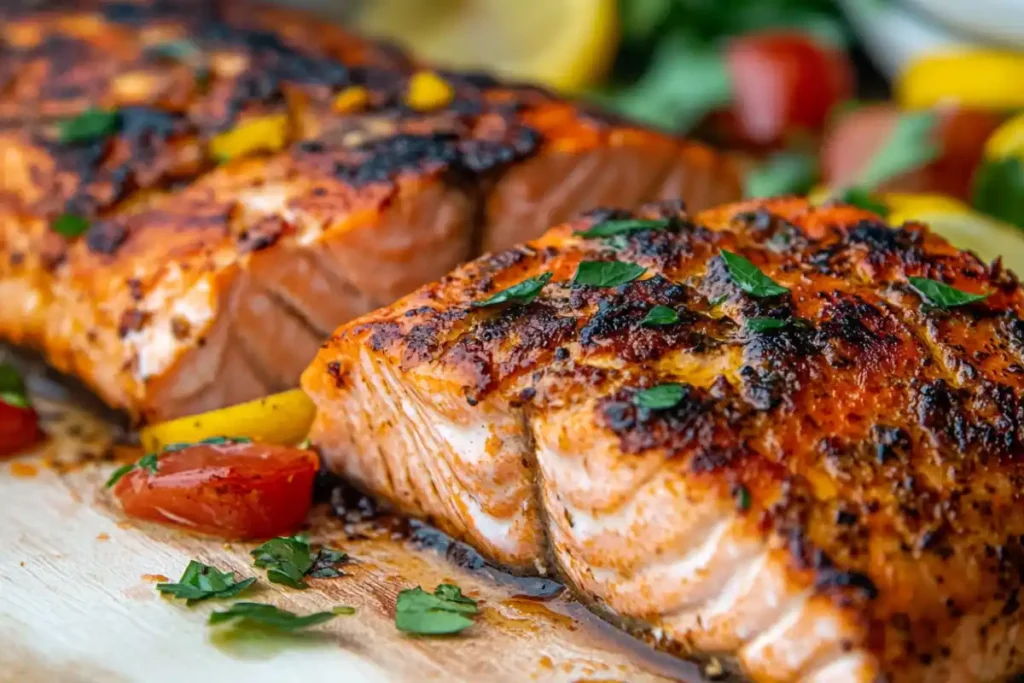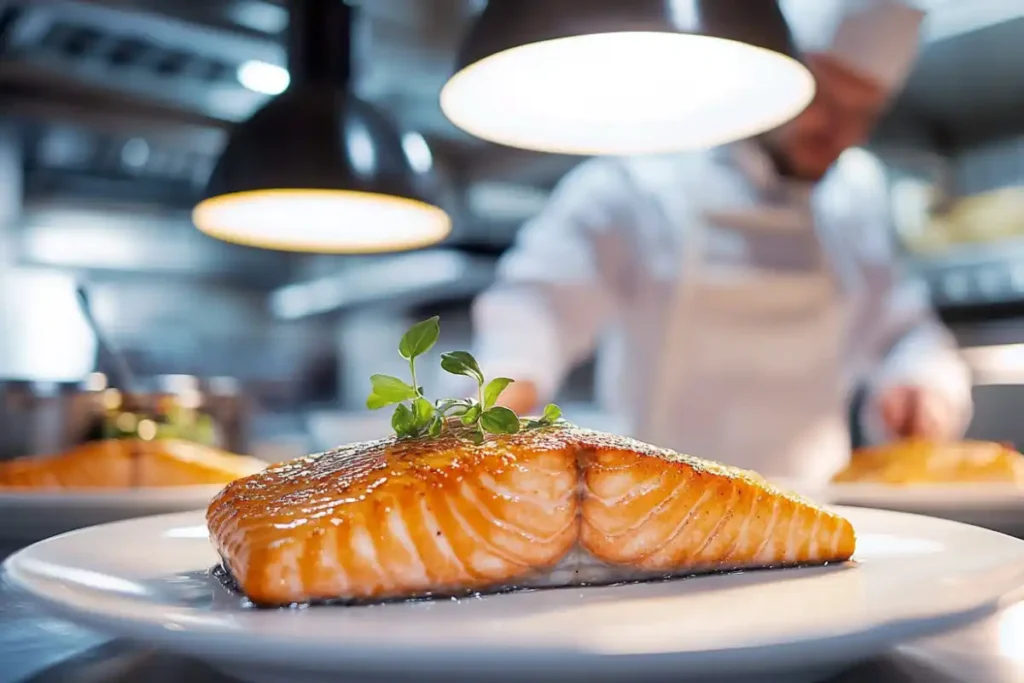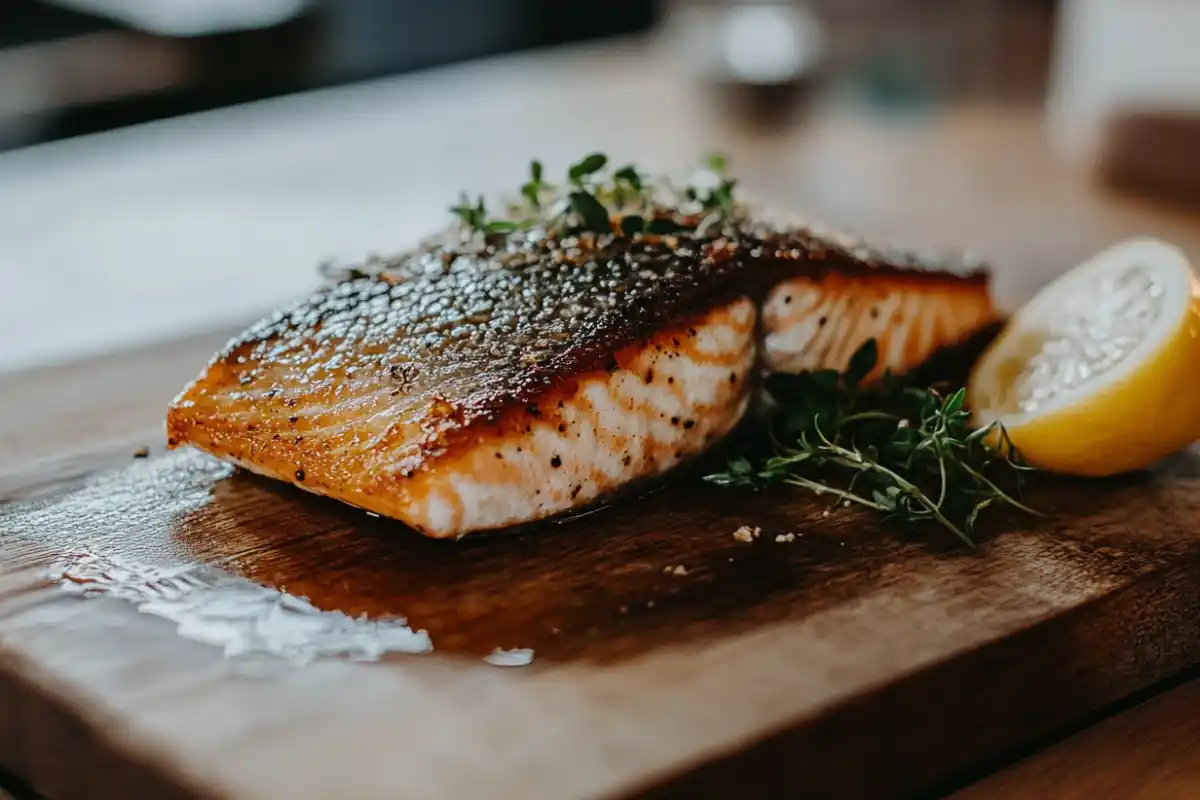Salmon is a favorite among seafood lovers, prized for its rich flavor, tender texture, and versatility in cooking. Whether baked, grilled, or pan-seared, it’s a go-to protein for quick and delicious meals. But here’s a question that often goes unnoticed: Does salmon need to rest after cooking?
Resting is a common practice with meats like steak and poultry, allowing juices to redistribute for optimal tenderness. But what about salmon? Should you let it sit for a few minutes before diving in, or is it best served straight off the heat?
In this article, we’ll break down the science behind resting salmon, its impact on texture and taste, and expert recommendations for getting the most out of your dish. Whether you’re a home cook or a seafood aficionado, this guide will ensure you cook salmon like a pro.
Understanding Resting in Cooking
What Does “Resting” Mean in Cooking?
Resting, in culinary terms, refers to the period after cooking when food is left undisturbed before serving. This step allows the internal juices to redistribute, preventing dryness and enhancing flavor. It’s a crucial technique for meats, ensuring they remain moist and tender after slicing.
But does the same logic apply to fish—especially salmon? Unlike steak, salmon has a more delicate structure, and its muscle fibers behave differently when exposed to heat. This raises the question: Is resting really necessary for salmon?
Why Do Meats and Some Fish Need Resting?
Resting is most commonly associated with red meats and poultry because of their dense muscle fibers. When cooked, these fibers contract, pushing juices toward the center. Letting the meat rest allows the juices to spread evenly before cutting, preserving moisture.
Fish, however, has a more delicate composition. Unlike beef or chicken, it contains shorter muscle fibers and less connective tissue, meaning it doesn’t retain juices the same way. Yet, certain types of fish—like salmon—can still benefit from a short resting period.
The key reason? Carryover cooking. Even after removing salmon from heat, residual heat continues to cook the fish slightly. Resting helps control this process, preventing overcooking and ensuring a tender, flaky texture.
There are no relevant internal linking opportunities related to cooking salmon or resting fish from the given website. Now, I’ll proceed with writing Part 2 and Part 3 of the article as per the outlined structure.
Does Salmon Specifically Need to Rest?
The Science Behind Resting Salmon After Cooking
So, does salmon need to rest the way meat does? The answer isn’t as straightforward as you might think. Unlike beef or poultry, salmon has shorter muscle fibers and contains less connective tissue. This makes it more delicate and prone to drying out if overcooked.
However, just like meat, salmon experiences carryover cooking—a process where the internal temperature continues to rise even after it’s removed from heat. This can lead to overcooking, which is why resting helps control the process. Allowing salmon to sit for a few minutes after cooking ensures that it remains juicy and prevents the texture from becoming too firm.
Moreover, salmon has natural oils that redistribute during resting. This enhances the overall flavor, making every bite more enjoyable. While a steak may require 5–10 minutes of resting time, salmon typically benefits from a shorter period—around 3 to 5 minutes.
Comparing Salmon to Other Types of Fish: Is It Necessary?
Not all fish benefit from resting. Lean fish like cod or tilapia tend to cool quickly and don’t undergo as much carryover cooking. Resting them could actually make them lukewarm and less appealing.
On the other hand, fatty fish—like salmon, trout, and mackerel—retain heat slightly longer due to their higher oil content. This means they can benefit from resting, just like certain meats. But unlike steak or chicken, salmon doesn’t require an extended resting time. A short pause before serving ensures it stays tender without compromising temperature.
For best results, remove salmon from heat when it reaches 125°F–130°F (for medium doneness) and let it rest to reach the optimal 135°F–140°F. This prevents overcooking while keeping it flaky and moist.
Benefits of Letting Salmon Rest
Retaining Moisture and Juiciness
Ever sliced into a beautifully cooked salmon fillet only to find it a bit dry? That’s what happens when the juices don’t get time to redistribute. Resting helps retain these natural juices, preventing them from seeping out too quickly when cut.
When salmon cooks, its protein fibers contract, pushing moisture toward the center. If you serve it immediately, those juices escape too soon, leaving the fish less succulent. Resting allows the juices to settle back into the fillet, ensuring a more moist and tender bite.

Enhancing Flavor Through Carryover Cooking
Flavor development doesn’t stop when salmon is removed from heat. Instead, resting allows any seasoning, marinades, or natural oils to meld together, enhancing the overall taste. The final moments of carryover cooking help the fish finish at the perfect doneness while keeping the flavors locked in.
Additionally, if you’re using a sauce or glaze, letting salmon rest gives it time to slightly thicken and adhere better, making every bite even more flavorful.
Preventing Overcooking for a Perfect Texture
One of the biggest mistakes when cooking salmon is leaving it on heat for too long. Because it’s a delicate fish, it can go from perfectly cooked to dry in a matter of minutes.
Resting serves as a buffer against this problem. Since salmon continues to cook even after it’s removed from the stove or oven, letting it sit for a few minutes ensures it doesn’t overshoot the desired temperature. This results in a flaky, tender texture rather than a dry or rubbery one.
There are no relevant internal linking opportunities from the provided website. However, if you’re looking for more salmon recipes or cooking tips, consider checking out other high-quality recipe sources.
How to Properly Rest Salmon After Cooking
How Long Should You Let Salmon Rest?
So, does salmon need to rest for an extended period like steak? The short answer is no. While meats like beef and chicken require 5–10 minutes of resting time, salmon is much more delicate and benefits from a shorter pause.
The ideal resting time for salmon is 3 to 5 minutes after removing it from heat. This brief period allows the carryover cooking process to finish, helping the internal temperature stabilize without overcooking the fish. If left for too long, salmon may cool down too much, losing its optimal texture and juiciness.
For best results, follow these simple steps:
- Remove salmon from heat a few degrees before your target doneness (125°F for medium, as it will rise to 130°F–135°F while resting).
- Let it sit undisturbed for 3–5 minutes before serving.
- Avoid cutting into it immediately—this helps keep the juices from escaping too soon.
Best Methods for Resting Cooked Salmon
While resting is straightforward, how you rest salmon also makes a difference. Here are the most effective ways to do it:
1. Covered vs. Uncovered Resting
- Covering lightly with foil traps residual heat, which can be helpful if you prefer a slightly more cooked texture.
- Leaving it uncovered allows steam to escape, preventing overcooking while maintaining a crisp outer layer (especially for grilled or pan-seared salmon).
2. Room Temperature Considerations
- Avoid resting salmon in a cold environment, as it can cool down too quickly.
- If serving with a sauce, let the salmon rest on a warm plate to keep it at an ideal temperature.
Resting correctly ensures that your salmon retains its moisture while achieving the perfect flakiness and flavor.
Myths and Misconceptions About Resting Salmon
Do You Always Need to Rest Salmon?
One common myth is that all salmon must rest after cooking. While resting improves juiciness and prevents overcooking, there are situations where immediate serving is perfectly fine:
- If salmon is slightly undercooked, skipping resting may help retain more heat for continued cooking on the plate.
- For sushi or lightly seared salmon, resting isn’t necessary since the goal is to keep the fish tender and slightly raw inside.
- If you’re serving salmon in a broth or sauce, resting may not be needed, as the sauce helps maintain moisture.
The key takeaway? Resting is beneficial but not always required, depending on your preferred texture and cooking method.
Does Resting Make a Noticeable Difference?
Some believe that resting salmon has no real impact on its texture or taste. However, tests by professional chefs and home cooks show that even a brief resting period enhances the overall eating experience.
By allowing the proteins to relax and the juices to redistribute, resting creates a more tender, evenly cooked fillet. The difference might not be as dramatic as with steak, but if you want perfectly cooked salmon every time, it’s a step worth taking.
Expert Opinions and Cooking Techniques
What Professional Chefs Say About Resting Salmon
If you’ve ever watched a professional chef cook salmon, you might have noticed that they often remove it from heat just before it’s fully done. Why? Because salmon continues to cook even after it leaves the pan, grill, or oven.
Renowned chefs agree that resting is an essential yet often overlooked step in preparing salmon. According to culinary experts, letting salmon rest for just a few minutes can:
- Prevent overcooking by allowing carryover heat to finish the cooking process.
- Retain moisture by letting the fish’s natural juices redistribute.
- Enhance flavor by giving seasonings and marinades time to settle.
Celebrity chefs like Gordon Ramsay and Thomas Keller emphasize precision in cooking salmon—not overcooking it and allowing a brief resting period for optimal results. Even in high-end restaurants, salmon is often plated and allowed to rest for a couple of minutes before serving.

Best Practices from Culinary Experts
If you want to cook salmon like a pro, follow these expert-approved techniques:
- Remove Salmon at the Right Temperature
- Take salmon off the heat when it reaches 125°F–130°F (medium doneness).
- Let it rest so it naturally rises to 135°F–140°F without drying out.
- Rest for Just the Right Amount of Time
- 3–5 minutes is the sweet spot—enough for juices to settle but not too long that it cools.
- Use the Right Resting Method
- Grilled or pan-seared salmon: Rest uncovered to keep the skin crispy.
- Baked or poached salmon: Lightly cover with foil to retain warmth without trapping too much moisture.
By applying these simple yet effective techniques, you’ll consistently achieve perfectly cooked, flavorful salmon every time.
FAQs Section: Answering Common Questions
1. How long should salmon rest after cooking?
Salmon should rest for 3 to 5 minutes after cooking. This short pause allows juices to redistribute, ensuring a moist and flavorful fillet.
2. Does resting salmon affect its taste and texture?
Yes! Resting salmon prevents overcooking, helps retain moisture, and enhances flavor by allowing the seasonings and natural oils to settle into the fish.
3. Should I cover salmon while it rests?
It depends on the cooking method:
- For crispy-skinned salmon, let it rest uncovered to maintain texture.
- For baked or poached salmon, loosely cover with foil to keep warmth without steaming it.
4. Can I skip the resting step if I’m in a hurry?
Technically, yes, but skipping resting may result in drier, less flavorful salmon. If time is tight, let it rest for at least 1–2 minutes before serving.
With these expert tips and answers to common questions, you now have all the knowledge needed to cook and serve salmon like a pro! Whether you’re grilling, baking, or pan-searing, remember—a little resting time can make a big difference!
Common Mistakes to Avoid When Resting Salmon
Letting Salmon Rest for Too Long
While resting salmon is important, leaving it for too long can be a mistake. Unlike steak or chicken, which need extended resting periods, salmon only requires 3 to 5 minutes. Resting it for too long can cause it to:
- Cool down excessively, making it less enjoyable to eat.
- Lose its flaky texture, especially if it sits uncovered in a cold environment.
- Overcook if it’s kept under a tight cover, trapping too much heat.
To avoid this, set a timer and serve your salmon right after the resting period for the best taste and texture.
Cutting into Salmon Too Soon
One of the biggest mistakes people make is slicing into salmon immediately after cooking. When this happens, the juices escape too quickly, leaving the fish dry and less flavorful. Instead, let it sit undisturbed for at least a few minutes, allowing the moisture to redistribute evenly throughout the fillet.
A good rule of thumb is: if you see juices pooling on the plate right after cutting, the salmon needed more time to rest.
Final Thoughts – Should You Let Salmon Rest?
Does Salmon Need to Rest? The Final Answer
So, does salmon need to rest after cooking? Yes—but only for a short time. Unlike meats that require extended resting, salmon benefits from a quick 3–5 minute pause to:
- Allow carryover cooking to complete.
- Keep the fish moist and flaky.
- Prevent overcooking while enhancing flavor.
Skipping this step might not ruin your dish, but it can make the difference between good salmon and perfectly cooked salmon.
The Key Takeaways
- Rest salmon for 3–5 minutes—just enough for the juices to settle.
- Don’t cover it too tightly—a light foil tent is fine, but sealing it can cause overcooking.
- Avoid cutting too soon—let the juices redistribute for better moisture and texture.
- Time it properly—resting too long can cool the fish too much, affecting the overall experience.
In the end, resting is a simple but effective trick to elevate your salmon dishes. Whether you’re grilling, baking, or pan-searing, following these tips will help you achieve a perfectly cooked, restaurant-quality meal every time. Happy cooking!
